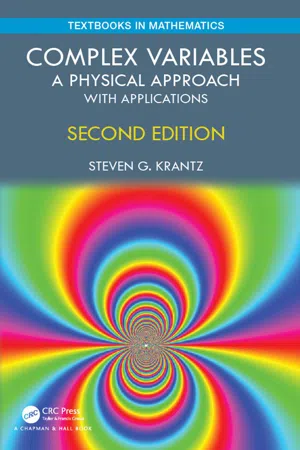
- 351 pages
- English
- ePUB (mobile friendly)
- Available on iOS & Android
eBook - ePub
About this book
The idea of complex numbers dates back at least 300 years—to Gauss and Euler, among others. Today complex analysis is a central part of modern analytical thinking. It is used in engineering, physics, mathematics, astrophysics, and many other fields. It provides powerful tools for doing mathematical analysis, and often yields pleasing and unanticipated answers.
This book makes the subject of complex analysis accessible to a broad audience. The complex numbers are a somewhat mysterious number system that seems to come out of the blue. It is important for students to see that this is really a very concrete set of objects that has very concrete and meaningful applications.
Features:
- This new edition is a substantial rewrite, focusing on the accessibility, applied, and visual aspect of complex analysis
-
- This book has an exceptionally large number of examples and a large number of figures.
-
- The topic is presented as a natural outgrowth of the calculus. It is not a new language, or a new way of thinking.
-
- Incisive applications appear throughout the book.
-
- Partial differential equations are used as a unifying theme.
Frequently asked questions
Yes, you can cancel anytime from the Subscription tab in your account settings on the Perlego website. Your subscription will stay active until the end of your current billing period. Learn how to cancel your subscription.
No, books cannot be downloaded as external files, such as PDFs, for use outside of Perlego. However, you can download books within the Perlego app for offline reading on mobile or tablet. Learn more here.
Perlego offers two plans: Essential and Complete
- Essential is ideal for learners and professionals who enjoy exploring a wide range of subjects. Access the Essential Library with 800,000+ trusted titles and best-sellers across business, personal growth, and the humanities. Includes unlimited reading time and Standard Read Aloud voice.
- Complete: Perfect for advanced learners and researchers needing full, unrestricted access. Unlock 1.4M+ books across hundreds of subjects, including academic and specialized titles. The Complete Plan also includes advanced features like Premium Read Aloud and Research Assistant.
We are an online textbook subscription service, where you can get access to an entire online library for less than the price of a single book per month. With over 1 million books across 1000+ topics, we’ve got you covered! Learn more here.
Look out for the read-aloud symbol on your next book to see if you can listen to it. The read-aloud tool reads text aloud for you, highlighting the text as it is being read. You can pause it, speed it up and slow it down. Learn more here.
Yes! You can use the Perlego app on both iOS or Android devices to read anytime, anywhere — even offline. Perfect for commutes or when you’re on the go.
Please note we cannot support devices running on iOS 13 and Android 7 or earlier. Learn more about using the app.
Please note we cannot support devices running on iOS 13 and Android 7 or earlier. Learn more about using the app.
Yes, you can access Complex Variables by Steven G. Krantz in PDF and/or ePUB format, as well as other popular books in Mathematics & Applied Mathematics. We have over one million books available in our catalogue for you to explore.
Information
Chapter 1
Basic Ideas
1.1 Complex Arithmetic
1.1.1 The Real Numbers
The real number system consists of both the rational numbers (numbers with terminating or repeating decimal expansions) and the irrational numbers (numbers with infinite, non-repeating decimal expansions). The real numbers are denoted by the symbol ℝ. We let ℝ2 = {(x, y) : x ∈ ℝ, y ∈ ℝ} (Figure 1.1).
1.1.2 The Complex Numbers
The complex numbers ℂ consist of ℝ2 equipped with some special algebraic operations. One defines
These operations of + and · are commutative and associative.
EXAMPLE 1 We may calculate that
Also

□
Of course we sometimes wish to subtract complex numbers. We define
Thus if z = (11, −6) and w = (1, 4) then
We denote (1, 0) by 1 and (0, 1) by i. We also denote (0, 0) by 0. If α ∈ ℝ, then we identify α with the complex number (α, 0). Using this notation, we see that
(1.1) |
In particular,
We may calculate that
(1.2) |
Thus every complex number (x, y) can be written in one and only one fashion in the form x · 1 + y · i with x, y ∈ ℝ. We usually write the number even more succinctly as x + iy.
EXAMPLE 2 The complex number (−2, 5) is usually written as
The complex number (4, 9) is usually written as
...Table of contents
- Cover
- Half Title
- Title Page
- Copyright Page
- Dedication
- Table of Contents
- Preface to the Second Edition for the Instructor
- Preface to the Second Edition for the Student
- Preface to the First Edition.
- 1 Basic Ideas
- 2 The Exponential and Applications
- 3 Holomorphic and Harmonic Functions
- 4 The Cauchy Theory
- 5 Applications of the Cauchy Theory
- 6 Isolated Singularities
- 7 Meromorphic Functions
- 8 The Calculus of Residues
- 9 The Argument Principle
- 10 The Maximum Principle
- 11 The Geometric Theory
- 12 Applications of Conformal Mapping
- 13 Harmonic Functions
- 14 The Fourier Theory
- 15 Other Transforms
- 16 Boundary Value Problems
- Appendices
- List of Notation
- Table of Laplace Transforms
- A Guide to the Literature
- References
- Index